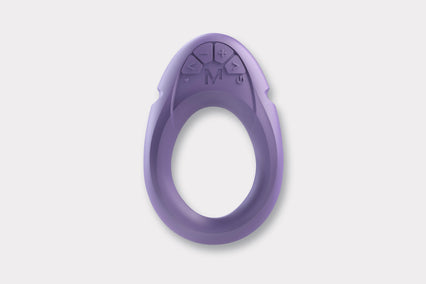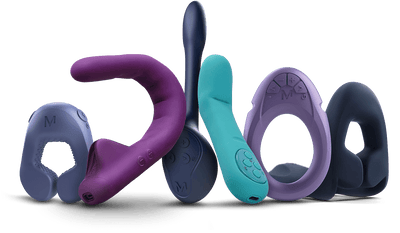Scrub-a-dub-dub - everyone deserves good, clean love! Whether your vibrator is a bedside essential or an occasional treat, keeping it clean is more important than you might think. A clean vibrator isn’t just about hygiene - it’s about protecting your health and keeping your pleasure purchase in tip-top, operational shape for years to come. From quick washes to deep sanitizing, let’s learn how to clean a vibrator to make sure it’s always ready to bring the satisfaction you deserve.
1. Find out the material of your vibrator
Step one is finding out what materials your vibrator is made with. Vibrators come in all sorts of materials, like silicone, ABS plastic, TPE/TPR, stainless steel, even glass. The material dictates the specific cleaning method, and what works for one type of material might harm another.
Porous materials such as TPE/TPR, jelly rubber, and Cyberskin can trap bacteria, making them tricky to clean. They need extra care, and it's a good idea to consider using a condom, especially when sharing. Conversely, nonporous materials like silicone, glass, and stainless steel are easier to keep clean and hygienic. If you're unsure what your vibrator is made of, check the packaging or look it up online. Knowing the material is crucial for picking the right way to keep it clean.
2. Check if your vibrator is waterproof or water-resistant
Before you toss your vibrator into the bath to soak up the suds, let's talk about waterproof vs. water-resistant vibrators. Waterproof vibrators can handle a full-on soak without damage to the electronic components. On the flip side, water-resistant vibes can handle splashes, ideal for shower time but not full-on submerging. Check the manufacturer's info to see if your vibrator is waterproof or water-resistant. When in doubt, if it's not labelled waterproof, play it safe and keep it away from too much water since vibrators and water don't mix well with electronics.
3. Read the manufacturer's instructions
Vibrator technology is evolving - fast, so while you may have an arsenal of vibes and think you’ve read it all before, some vibrators have special cleaning instructions. It’s good practice to check and follow the manufacturer's cleaning guidelines, as different materials may need specific care. If you're unsure how to clean your vibrator, check the manufacturer's website or ask your local sex toy store for advice tailored to your sex toy's material and design.
4. Remove the batteries before cleaning
If your vibrator uses physical batteries, remember to take out the batteries before cleaning. If it’s a rechargeable vibrator, make sure it’s unplugged before cleaning. This helps avoid accidental motor activation during cleaning, protecting your vibrator and yourself. Also, avoid getting the charging ports or electrical components wet to prevent charging malfunctions or safety issues.
5. How to clean a silicone vibrator
High-quality silicone is a top-notch vibrator choice thanks to its non-porous, hypoallergenic, and phthalate-free properties. Most vibrators will be made of body-safe silicone.
However, watch out for "silicone blends", too, often mistaken for pure silicone. Some vibrators are marketed with names like TPR-Silicone or Cyber-Silicone, these are considered silicone blends and not full silicone, so these cleaning instructions don’t apply to blends. These silicone blends can harbor bacteria due to their slightly porous nature. For safe play, opt for premium vibrators like MysteryVibe’s medical-grade, body-safe silicone vibrators.
Here are a few easy methods to clean your silicone vibrator:
✅ Wipe it: Grab a damp cloth with body-safe soap and gently wipe the silicone surface. It's a quick and effective way, especially for non-water-resistant vibrators or for a speedy cleanup.
✅ Wash with soap and water: Give your waterproof silicone vibrator a spa-like treatment by immersing them in water. If your vibrator is showerproof, rinse it under running water with soap. Treat them like your skin - scrub the surface gently for about 30 seconds, then rinse completely and air dry.
✅ Use a sex toy cleaner: While sex toy cleaner isn’t necessary, for extra cleanliness and peace of mind, use a sex toy cleaner with warm water.
Here is what you want to avoid when cleaning a silicone vibrator:
❌ Avoid boiling: Boiling, a typical cleaning method for non-motorized silicone sex toys, can permanently harm the motorized components in vibrators.
❌ Skip the oven: While it might be tempting to bake silicone vibrators for sterilization, it's not recommended for items with electronic parts as it can lead to malfunctions or total failure.
❌ Steer clear of the dishwasher: The dishwasher's high heat and strong water jets are too harsh for the motorized components of a vibrator, risking damage to both electronic and silicone components.
❌ Stay away from hydrogen peroxide and oil-based cleaners: These can chemically break down silicone, causing it to swell and potentially make the vibrator material unsafe for use.
❌ Be cautious with strong chemicals: Cleaning agents like bleach, vinegar, baking soda, or OxiClean can harm electronic parts and corrode metal contacts. If your vibrator manufacturer approves these chemicals, use them carefully around electronic parts to prevent damage.
❌ Take care with alcohol: Cleaning with alcohol is up for debate. While some manufacturers allow rubbing alcohol on their silicone vibrators, others advise against it due to the risk of material damage and skin irritation. Always refer to and follow the manufacturer's cleaning instructions, especially when using alcohol-based products.
5. Choose the best way to clean your vibrator
We covered a few ways to clean your silicone vibrator, but you can wipe, wash, disinfect, or sterilize your vibrators too. Depending on the material and how deep of a clean you want, here are a few other ways to clean your vibrator.
How to wipe a vibrator
Sex toy cleaning wipes are a handy solution for keeping your vibrator clean, especially for those not safe for water. Most vibrators can be wiped clean quickly, which is great if you're unsure about the material or water resistance. Opt for sex toy wipes that are body-safe and free from fragrances or dyes. Remember, while these wipes are suitable for a quick clean, they're not a substitute for a thorough wash with mild soap and water to eliminate all fluids and bacteria.
How to wash a vibrator
Washing is usually the way to go for cleaning vibrators and is suggested for most vibrator materials, just make sure to check the water safety rating first.
Wash your vibrator with mild soap and water
Washing your vibrator with mild soap and water is a simple, suggested way to keep it clean and hygienic. This method works well for all kinds of materials, whether your vibe is waterproof or showerproof. Skip very hot water for porous vibrators to prevent any damage.
Wet your vibrator, and a washcloth or sponge, with warm water. Put some gentle soap on the cloth, and give your vibrator a gentle scrub for about a minute. Rinse under running water, without fully submerging if it isn’t waterproof. Try not to let water enter the electrical parts or openings to protect the internal mechanisms. A soft bristle toothbrush can help ensure a thorough clean if you have any grooves or tricky spots. After cleaning, rinse the vibrator under warm running water and let it dry.
Choose a mild soap like liquid hand soap or a clear body wash without microbeads or moisturizers to clean your vibrators. Make sure the soap is body-safe and avoid using anything with dyes or fragrances that might leave residues on the vibrator. While antibacterial soap is fine, it's not necessary.
Apply a specialized sex toy cleaner
For those sensitive or tough-to-clean vibrators, special sex toy cleaners are a solid choice. These cleaners, in spray or foam forms, are made just for sex toys. To use a sex toy cleaner, spray or foam it on the vibrator, let it sit for a bit, and then wipe or rinse it clean. For water-resistant vibrators, skip dunking under water and stick to a damp cloth and a rinse under the faucet.
How to sanitize a vibrator
You don’t. Sanitizing methods like steam cleaning and baking aren't the best for vibrators, as the extreme temperatures can mess up the electronic parts.
Dishwashing is a no-go, too, even for waterproof vibrators. The dishwasher's heat and jets could wreck the motor and how it works. So, it's best to avoid these methods for keeping your vibrators clean.
How to disinfect a vibrator
Disinfecting a vibrator goes beyond regular cleaning, especially if dealing with multiple users, infections, or funky odors. While soap and water are great for routine cleaning, disinfecting means using more potent stuff like bleach, vinegar, alcohol, baking soda, or OxiClean. These can tackle germs effectively but be careful as they might damage the vibrator or irritate your skin if not rinsed off thoroughly. Some folks swear by these chemicals for cleaning, but opinions on safety can vary. It's always a good idea to check the manufacturer's cleaning instructions on harsh chemicals and choose methods that won't compromise your health or the vibrator's quality. Remember, while these methods might be okay for certain porous vibrators, avoid using them on any porous vibrators that could trap chemicals and pose risks to genital tissues.
If vinegar is your go-to, mix a cleaning solution with equal parts white vinegar and water. Get a soft, damp cloth and gently wipe down the non-motorized parts of the vibrator with the vinegar solution. After wiping it down, rinse the cloth with warm water and give your vibrator another wipe to remove any leftover vinegar. If you're using alcohol, follow the same steps as with vinegar, but swap vinegar for 70% isopropyl alcohol.
If you're using bleach, avoid applying it directly to vibrators. Instead, mix 10% bleach and 90% water for disinfecting waterproof, non-porous vibrators. Wipe the vibrator with this mix (avoid soaking), then rinse thoroughly to get rid of any bleach residue. After that, wash it with soap and water to maintain the natural pH balance.
How to sterilize vibrators
To effectively and safely sterilize vibrators, boiling and UV sterilization are standard methods, each with specific uses. Sterilizing with boiling water is simple, but don't use it for vibrators to avoid damage to their electronic parts. On the other hand, UV sterilization offers a modern, hassle-free option for various materials, including waterproof and non-waterproof vibrators. UV light devices for sanitizing vibrators kill bacteria and viruses without moisture damage. It's a dry, chemical-free alternative that is gentle on the material for thorough sterilization.
7. Dry thoroughly
Once you've cleaned your vibrator, make sure to dry it thoroughly before storing it to avoid mold or bacteria growth. Damp vibrators can get moldy, and nobody wants that. There are two good ways to dry it: air drying or using a towel. For air drying, just put the clean vibrator on a towel and let it dry completely for about 24 hours. This way, there's no lingering moisture to attract bacteria. Or you can use a clean towel or paper towel to dry off your vibrator before putting it away. And if it's battery-operated, remember to take out the batteries before cleaning and air drying, with the battery case open to prevent any damage from moisture.
Tips for cleaning your vibrator
Clean your vibrator before and after each use
The key to keeping your vibrator in good shape is cleaning it after every use. It's easy to overlook this step, but skipping the cleaning can leave icky bacteria hanging out, which might cause yeast infections, UTIs, bacterial vaginosis, and even spread STDs. Plus, old lubes and fluids can attract dust and dirt - not what you want inside you. If you're sharing vibrators, give them a good clean before passing them on to avoid mix-ups. And even for solo play, remember to clean properly if switching between anal and vaginal use to keep things hygienic and safe. Using a condom on the vibrator can make cleaning easier - remember to toss it after use, and when you're not in a rush, take the time to clean it thoroughly, especially if you're sharing.
If your vibrator has been sitting around for a bit, it's a good idea to clean it before you use it. Even if you store your vibrators in a clean place, they can collect dust, pollen, or pet hair. Be sure to clean your vibrator right out of the box too! While it's exciting to have a new vibrator, think about all the hands it went through from manufacturing to packaging - it might have picked up some contaminants along the way.
Store your vibrators the right way
Keeping your vibrators clean goes beyond just washing them; how you store them matters, too. Store them in a clean, dry, cool, dark place away from sunlight and water to prevent bacteria and mold. This helps maintain your vibrators integrity and hygiene. Also, don't keep them near items like deodorant sticks or fake tan bottles, as they can harbor germs.
Ditch vibrators that change color, tear, or develop odors
When your vibrators start looking funky - changing colors, tearing, or smelling weird - it's time to toss them out. Safety first, even if you're attached to them. Over time, vibrator materials break down, becoming a cozy spot for bacteria. Cleaning won't fix it, and using damaged vibrators is risky. Be extra careful with porous materials like silicone blends, jelly rubber, PVC, vinyl, TPR, TPE, elastomer, etc. They soak up germs and might have harmful chemicals like phthalates.
While high-quality vibrators made from stainless steel, Pyrex, silicone, and glass may cost more, they last longer and are easier to clean. Cheaper options made from porous materials like jelly rubber and hard plastic will wear out quicker. Investing in a good, nonporous vibrator is better for your wallet and health in the long run.
Takeaway
Keeping your vibrator clean is an important part of protecting your body and elevating your sexual experience. By investing some TLC into proper cleaning and storage, you can make every session as safe and satisfying as the first. If you’ve gotten to the end of this cleaning tutorial and realize you need a new vibe, check out our award-winning, body-safe silicone vibrators. With these cleaning methods and tips, you can prioritize your health, extend the life of your favorite vibrator, and make sure it's ready to go when you are. Clean vibes equal good vibes, every single time.












































